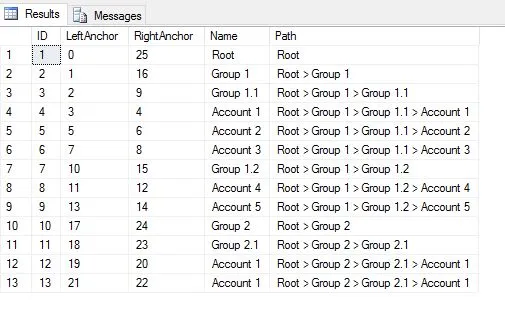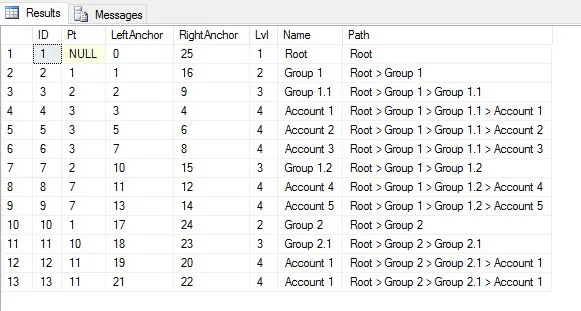我有一张包含公司会计科目表详细信息的表格 - 这些数据基本上是以嵌套集合的形式存储的(在SQL Server 2014上),每条记录都有左和右锚定点 - 没有父ID。
示例数据:
ID LeftAnchor RightAnchor Name
1 0 25 Root
2 1 16 Group 1
3 2 9 Group 1.1
4 3 4 Account 1
5 5 6 Account 2
6 7 8 Account 3
7 10 15 Group 1.2
8 11 12 Account 4
9 13 14 Account 5
10 17 24 Group 2
11 18 23 Group 2.1
12 19 20 Account 1
13 21 22 Account 1
我需要为每个记录实现路径的具体化,以便我的输出看起来像这样:
ID LeftAnchor RightAnchor Name MaterializedPath
1 0 25 Root Root
2 1 16 Group 1 Root > Group 1
3 2 9 Group 1.1 Root > Group 1 > Group 1.1
4 3 4 Account 1 Root > Group 1 > Group 1.1 > Account 1
5 5 6 Account 2 Root > Group 1 > Group 1.1 > Account 2
6 7 8 Account 3 Root > Group 1 > Group 1.1 > Account 3
7 10 15 Group 1.2 Root > Group 1 > Group 1.2
8 11 12 Account 4 Root > Group 1 > Group 1.2 > Acount 4
9 13 14 Account 5 Root > Group 1 > Group 1.2 > Account 5
10 17 24 Group 2 Root > Group 2
11 18 23 Group 2.1 Root > Group 2 > Group 2.1
12 19 20 Account 1 Root > Group 2 > Group 2.1 > Account 10
13 21 22 Account 1 Root > Group 2 > Group 2.1 > Account 11
虽然我已经使用CTE实现了这一点,但查询速度非常慢。当输出大约有1200条记录时,运行时间接近两分钟。
以下是我代码的简化版本:
;with accounts as
(
-- Chart of Accounts
select AccountId, LeftAnchor, RightAnchor, Name
from ChartOfAccounts
-- dirty great where clause snipped
)
, parents as
(
-- Work out the Parent Nodes
select c.AccountId, p.AccountId [ParentId]
from accounts c
left join accounts p on (p.LeftAnchor = (
select max(i.LeftAnchor)
from accounts i
where i.LeftAnchor<c.LeftAnchor
and i.RightAnchor>c.RightAnchor
))
)
, path as
(
-- Calculate the Account path for each node
-- Root Node
select c.AccountId, c.LeftAnchor, c.RightAnchor, 0 [Level], convert(varchar(max), c.name) [MaterializedPath]
from accounts c
where c.LeftAnchor = (select min(LeftAnchor) from chart)
union all
-- Children
select n.AccountId, n.LeftAnchor, n.RightAnchor, p.level+1, p.path + ' > ' + n.name
from accounts n
inner join parents x on (n.AccountId=x.AccountId)
inner join path p on (x.ParentId=p.AccountId)
)
select * from path order by LeftAnchor
理想情况下,这个查询只需要几秒钟(最多)就可以运行。由于数据库连接是只读的,我无法对数据库本身进行任何更改,所以有没有人能想出更好的方法来编写这个查询?

